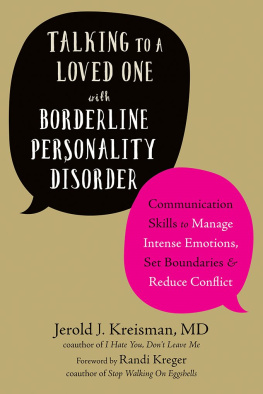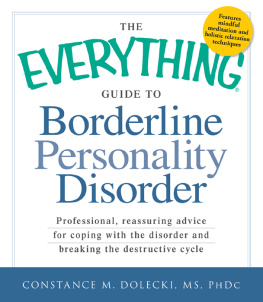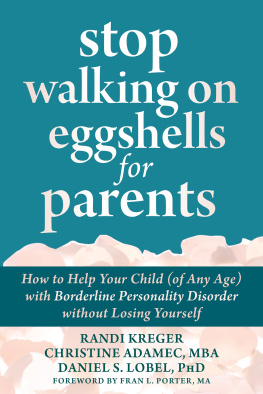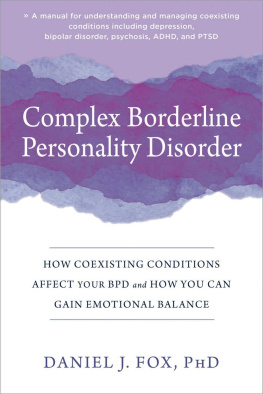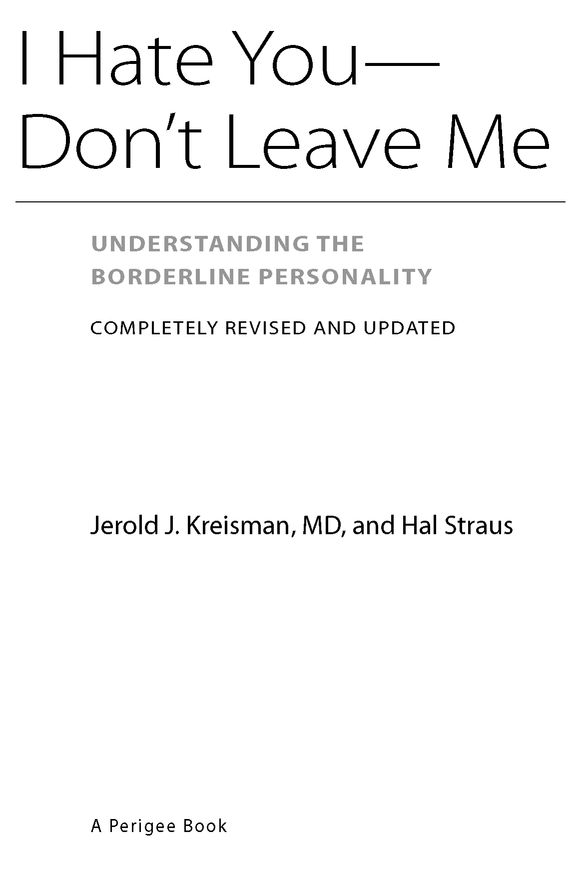Table of Contents
I Hate YouDont Leave Me was the first book to introduce BPD to the public. We are all indebted to Dr. Kreisman for his pioneering efforts to raise awareness of this painful mental disorder. As research and treatment have advanced so much since then, we welcome this needed update to what is now a classic text.
Valerie Porr, MA, president and founder of Treatment and Research
Advancements National Association for Personality Disorder, and
author of Overcoming BPD
Dr. Kreisman and Hal Straus have thoroughly revised their twenty-year classic to include the latest advances in therapies and medications while retaining the rich, easy-to-read style of the first edition. Real-life case studies and the extensive list of references illuminate our understanding of borderline personality not only for the general public but for professionals as well. This book belongs on the bookshelf of patients, their friends and family, and for all those who help in their healing.
Randi Kreger, author of Stop Walking on Eggshells and
The Essential Family Guide to Borderline Personality Disorder
As all things,
still,
for Doody
ACKNOWLEDGMENTS
The efforts necessary to complete this new edition required both great assistance and forbearance. Assistance initiated with Bruce Seymour of Goodeye Photoshare (goodeye-photoshare.com), who donated much time and effort with technical issues producing the manuscript. Another dear friend, Eugene Horwitz, massaged frustrating computer conundrums. My secretaries, Jennifer Jacob and Cindy Fridley, helped gather articles and books incorporated into the work. Lynne Klippel, energetic librarian at DePaul Health Center, St. Louis, tracked down helpful references.
Great forbearance was demonstrated by my partners and staff of Allied Behavioral Consultants of St. Louis, who allowed me the freedom to pursue this task. My wife, Judy, and children, Jenny, Adam, Brett, and Alicia, and the little ones, Owen and Audrey and a Player to Be Named Later, courageously consented to miss a few ball games, several plays, and a lot of movies while I indulged sunny afternoons researching and writing.
We wish to thank our agent, Danielle Egan-Miller, at Browne & Miller Literary Associates, and John Duff and Jeanette Shaw, our publisher and editor, respectively, at Perigee/Penguin. All played important roles in shaping the contents of this book.
PREFACE
When the first edition of I Hate YouDont Leave Me was published in 1989, very little information was available to the general public on the subject of Borderline Personality Disorder. Research into the causes of, and treatments for, BPD was in its infancy. The few articles that had appeared in consumer magazines vaguely outlined the disorder as it began to infiltrate the American consciousness. There were virtually no books on BPD for the patient or the patients close family and friends. The response to our book, both in this country and abroad with foreign translations, has been most gratifying. My intention to produce a work accessible to the general public, yet functional for professionals with useful references, seems to have been fulfilled.
To say that a lot has happened in this area over twenty years is obviously a vast understatement. Several other books on BPD have been published, including our own Sometimes I Act Crazy (2004), describing the experience of this illness from the perspectives of afflicted individuals, family members, and treating professionals. Greater understanding of the etiology, biological, genetic, psychological, and social implications and treatment approaches has added exponentially to our knowledge. So the challenge of writing this second edition was to highlight and explain the most important advances, present useful, referenced information for the professional, and yet manage the length of the book so it can continue to serve as an engaging introduction to BPD for the lay reader. To achieve this balance, a few chapters needed only updating, but others, especially those on the possible biological and genetic roots of the syndrome, were extensively rewritten in order to incorporate the latest scientific research. Additionally, specific psychotherapeutic approaches and drug treatments have evolved to such an extent that it was necessary to include entirely new chapters on these topics. The books reliance on real-life case stories, to give the reader insight into what life is like forand witha borderline, continues in this edition, though the backdrop of these stories was altered to reflect the changes in American society from one century to the next. Perhaps the biggest change from the first edition is one of overall tone: whereas the prognosis for patients was understandably bleak two decades ago, it is now (based on numerous longitudinal studies) much more positive.
And yet, despite these advancements, it is disappointing to review the preface to the first edition and recognize that misunderstanding and especially stigma still run rampant. BPD remains an illness that continues to confuse the general public and terrify many professionals. As recently as 2009, a Time magazine article reported that [b]orderlines are the patients psychologists fear most and [m]any therapists have no idea how to treat [them]. As Marsha Linehan, a leading expert on BPD, noted, Borderline individuals are the psychological equivalent of third-degree burn patients. They simply have, so to speak, no emotional skin. Even the slightest touch or movement can create immense suffering. Nevertheless, development of specific therapies and drugs targeted at the disorder (see chapters 8 and 9) has provided some relief from patients burdens, and perhaps more important, public awareness of BPD has grown significantly from what it was in 1989. As you will see in the Resources section at the end of this book, the number of books, websites, and support groups has proliferated. Perhaps the clearest sign of public acknowledgment occurred in 2008, when Congress designated May as Borderline Personality Disorder Awareness Month.
Still, huge challenges remain, especially financial. Reimbursement for cognitive medical services is shamefully, disproportionately small. For one hour of psychotherapy, most insurance companies (as well as Medicare) pay less than 8 percent of the reimbursement rate allocated for a minor outpatient surgical procedure, such as a fifteen-minute cataract operation. Research for BPD has also been inadequate. The lifetime prevalence rate of BPD in the population is twice that of both schizophrenia and bipolar disorder combined, and yet the National Institute of Mental Health (NIMH) devotes less than 2 percent of the monies apportioned to the studies of those illnesses to research on BPD. As our country tries to control health care costs, we must understand that investment in research will eventually improve the health of this country and thus lower long-term health care costs. But we will need to reevaluate the priorities we place on limited resources, and recognize that rationing may impact not only delivery of care but also advancements toward a cure.
Many in the public and professional realm have kindly referred to the original publication of this book as the classic in the field. After two decades, it has been a labor of love to revisit our work and update the voluminous data accumulated during this interval. It is my hope that by refreshing and refurbishing our original effort we can play a small part in rectifying the misunderstandings and erasing the stigma associated with BPD and retain the honor of being referenced widely as a primary resource.


